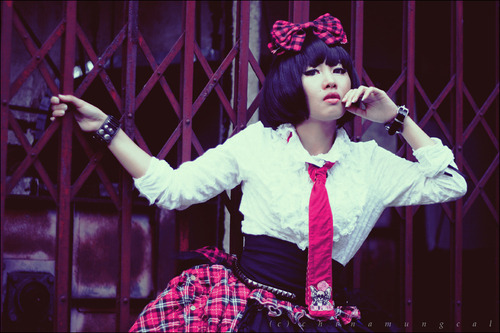Kon'nichiwa!
So I've been doing some homework on a fashion style I previously knew little about. Last week, Elou posted a photo of some dresses on our tumblr. Now, when I saw them I thought, "Victorian style, New Look skirts, blue: I want!" I then went to find the designer, and discovered that the label in question, Mary Magdalene, is a designer of Lolita dresses and clothing. This intrigued me. When I thought of the Japanese fashion subculture that is Lolita, I (as no doubt do many of you) immediately got an image of pink bows, white lace, cutsey motifs and lots of ruffles. In fact, that image is only one part of the whole Lolita style.
Let me start at the beginning. Loltia as a fashion style started in the 1970s with the shops Pink House, Angelic Pretty, and Milk. The style became a fashion subculture in the 1980s, with the emergence of labels such as Innocent World, Baby the Stars Shine Bright (1988), Mary Magdalene, and Metamorphose Temps de Fille (1997), as well as the influence of "Visual Kei" bands such as Dir En Grey, Malice Mizer and Princess Princess. The lead singer of Malice Mizer, Mana, set up his own fashion line in 1999 called Moi-Meme-Moitie, and coined the term "Elegant Gothic Lolita" to describe his style.
Traditionally, Lolita is designed in a way to make the wearer seem as childlike and innocent as possible. There is an unfamiliar lack of sexualization; outfits are demure and preserve modesty. A traditional Lolita outfit avoids exposing too much flesh; the bell-shaped skirt is worn, at shortest, two inches above the knee, but usually just below. Dresses or blouses have puffed sleeves to cover the shoulders, and bloomers are worn under skirts and dresses to preserve modesty even more. Socks are worn knee-high to avoid revealing too much leg. Shoes tend to be of the Mary-Jane or platform boot variety, and a headpiece of somekind is nearly always worn. I also discovered that the sleeveless dresses that are sometimes worn are called "jumperskirts" instead; as they do not cover the shoulders, they are often considered not fitting to wear without a blouse, just as a skirt would be.
A jumperskirt:
In my research, I discovered that there are many different branches of Lolita. The most 'popular' or well known, and certainly the most extravagent, is the Sweet Lolita, characterised by the use of mostly pink, white or blue, or pastel colours, lace, ruffles, bows, cute motifs or patterns, a minimum of makeup, and girly or childish hairstyles such as pigtails or curls.
Then there's Goth Lolita, a style that is Victorian in its gothicity rather than cyber, and uses dark, velvety colours to enhance the black, and is combined with dark eye makeup and sometimes red lips.
Punk Lolita is another sub-style; one that is apparently difficult to master. The punk look uses the tartan or graphic prints of a typical punk style, as well as the rougher edges and shorter shirts, however it still retains a childlike feel and the traditional silhouette.
Aristocrat Lolita is slightly different from the other styles. It holds more maturity than the others, and tends to include floor-length skirts as well as the usual bell-shaped knee lengths. Aristocrat Lolitas tend to wear dark colours and use darker makeup, and lean more towards Victorian elegance than the more childish aspects of Lolita.
Hime, or Princess, Lolita is a take on Sweet Lolita and characterises (as you can imagine), the same pastelly colours enhanced by princessy or 'royal' accessories.
Kodana, or 'boy-style' or Dandy, is a male take on Lolita fashion. It is worn by both boys and girls, and uses young boy's Victorian clothing styles. It's often characterised by just-below-the-knee trousers with knee socks tucked in, or a Dandy-fied waistcoat and trouser combination. A hat of somekind is a often used accessory. Makeup is kept at a minimum, and hair is usually short or bundled into a bun under a hat.
Of course, these aren't the only sub-styles. Others include Casual, Country, Shiro and Kuro (white and black), Classic, Guro (Gore), Ero (erotic) which despite its name still retains demure modesty incomparison to Western 'erotic' styles, Wa and Qi (traditional Japanese and Chinese influences), Sailor and many more.
Lolita style is one that seems to have no parallel in Western culture, and although it has filtered through and been adapted and adopted by a select group of Westerners, I'm inclined to think that the Japanese are the only ones who can pull it off with such casual simplicity, despite the often extravagent outfits. Although, please feel free to correct me if you consider me wrong...
~ Sparrow
Shops or labels mentioned: Angelic Pretty, Metamorphose Temps de Fille, Innocent World, Moi-Meme-Moitie.
Sources include: lolitafashion, virtualjapan







No comments:
Post a Comment